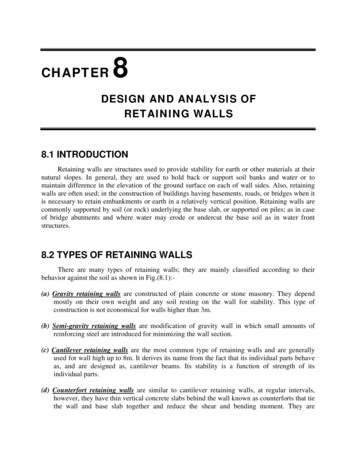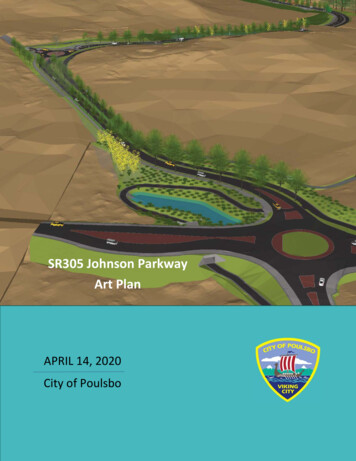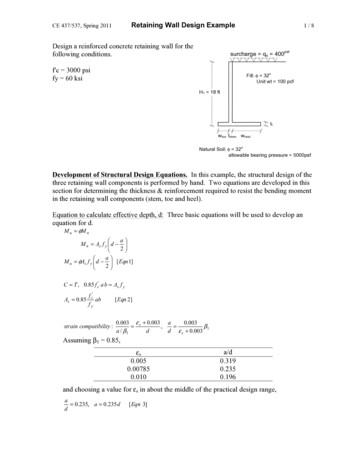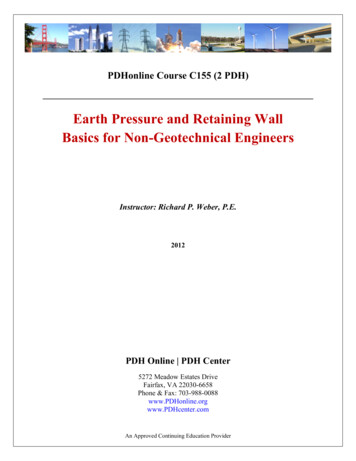
Transcription
PDHonline Course C155 (2 PDH)Earth Pressure and Retaining WallBasics for Non-Geotechnical EngineersInstructor: Richard P. Weber, P.E.2012PDH Online PDH Center5272 Meadow Estates DriveFairfax, VA 22030-6658Phone & Fax: 703-988-0088www.PDHonline.orgwww.PDHcenter.comAn Approved Continuing Education Provider
www.PDHcenter.comPDH Course C155www.PDHonline.orgEarth Pressure and Retaining Wall Basicsfor Non-Geotechnical EngineersRichard P. WeberCourse ContentContent Section 1Retaining walls are structures that support backfill and allow for a change of grade. Forinstance a retaining wall can be used to retain fill along a slope or it can be used tosupport a cut into a slope as illustrated in Figure 1.FillRetaining Wall to Support a Fill.CutRetaining Wall to Support a Cut.Figure 1 – Example of Retaining WallsRetaining wall structures can be gravity type structures, semi-gravity type structures,cantilever type structures, and counterfort type structures. Walls might be constructedfrom materials such as fieldstone, reinforced concrete, gabions, reinforced earth, steel andtimber. Each of these walls must be designed to resist the external forces applied to thewall from earth pressure, surcharge load, water, earthquake etc. Prior to completing anyretaining wall design, it is first necessary to calculate the forces acting on the wall.Page 1 of 20
www.PDHcenter.comPDH Course C155www.PDHonline.orgThis course is not intended to be exhaustive nor does it discuss a wide range of surchargeloads or other lateral forces that might also act on a wall such as earthquake. There aremany textbooks and publications that explain loading conditions in depth including: Foundations and Earth Structures, NAVFAC, Design Manual 7.2Retaining and Flood Walls, Technical Engineering and Design Guides AsAdapted from The US Army Corps Of Engineers, No. 4, ASCEStandard Specifications for Highway Bridges, AASHTOIn the following sections, we will first discuss basic considerations necessary forcalculating lateral earth pressure and then how to apply these pressures in developing theforce. We will illustrate how the lateral forces are combined with vertical forces tocalculate the factor of safety with respect to sliding, overturning and bearing capacity.These three components are important elements in retaining wall design. Structuraldesign of a retaining wall is beyond the scope of this course.Content Section 2Categories of Lateral Earth PressureThere are three categories of lateral earth pressure and each depends upon the movementexperienced by the vertical wall on which the pressure is acting as shown in Figure 2(Page 4). In this course, we will use the word wall to mean the vertical plane on whichthe earth pressure is acting. The wall could be a basement wall, retaining wall, earthsupport system such as sheet piling or soldier pile and lagging etc.The three categories are: At rest earth pressureActive earth pressurePassive earth pressureThe at rest pressure develops when the wall experiences no lateral movement. Thistypically occurs when the wall is restrained from movement such as along a basementwall that is restrained at the bottom by a slab and at the top by a floor framing systemprior to placing soil backfill against the wall.The active pressure develops when the wall is free to move outward such as a typicalretaining wall and the soil mass stretches sufficiently to mobilize its shear strength.On the other hand, if the wall moves into the soil, then the soil mass is compressed,which also mobilizes its shear strength and the passive pressure develops. This situationmight occur along the section of wall that is below grade and on the opposite side of thePage 2 of 20
www.PDHcenter.comPDH Course C155www.PDHonline.orgretained section of fill. Some engineers might use the passive pressure that developsalong this buried face as additional restraint to lateral movement, but often it is ignored.In order to develop the full active pressure or the full passive pressure, the wall mustmove. If the wall does not move a sufficient amount, then the full active or full passivepressure will not develop. If the full active pressure does not develop, then the pressurewill be higher than the expected active pressure. Likewise, significant movement isnecessary to mobilize the full passive pressure.How movement affects development of the active and passive earth pressure is illustratedin Figure 3 shown on Page 4. Note that the “at rest” condition is shown where the wallrotation is equal to 0, which is the condition of zero lateral strain.Page 3 of 20
www.PDHcenter.comPDH Course C155www.PDHonline.orgActive CaseAt Rest CasePassive Case(Wall movesaway from soil)(No movement)(Wall movesinto soil)Figure 2 - Wall MovementFigure 3 - Effect of Wall Movement on Wall Pressure [Ref: NAVFAC DM-7]Page 4 of 20
www.PDHcenter.comPDH Course C155www.PDHonline.orgFrom Figure 3 it is evident that: As the wall moves away from the soil backfill (left side of Figure 2), the activecondition develops and the lateral pressure against the wall decreases with wallmovement until the minimum active earth pressure force (Pa) is reached. As the wall moves towards (into) the soil backfill (right side of Figure 2), thepassive condition develops and the lateral pressure against the wall increases withwall movement until the maximum passive earth pressure (Pp) is reached.Thus the intensity of the active / passive horizontal pressure, which is a function of theapplicable earth pressure coefficient, depends upon the degree of wall movement sincemovement controls the degree of shear strength mobilized in the surrounding soil.Calculating Lateral Earth Pressure CoefficientsLateral earth pressure is related to the vertical earth pressure by a coefficient termed the: At Rest Earth Pressure Coefficient (Ko)Active Earth Pressure Coefficient (Ka)Passive Earth Pressure Coefficient (Kp)The lateral earth pressure is equal to vertical earth pressure times the appropriate earthpressure coefficient. There are published relationships, tables and charts for calculatingor selecting the appropriate earth pressure coefficient.Since soil backfill is typically granular material such as sand, silty sand, sand withgravel, this course assumes that the backfill material against the wall is coarse-grained,non-cohesive material. Thus, cohesive soil such as clay is not discussed. However, thereare many textbooks and other publications where this topic is fully discussed.At Rest CoefficientDepending upon whether the soil is loose sand, dense sand, normally consolidated clay orover consolidated clay, there are published relationships that depend upon the soil’sengineering values for calculating the at rest earth pressure coefficient. One commonearth pressure coefficient for the “at rest” condition in granular soil is:Ko 1 – sin(φ)(1.0)Where: Ko is the “at rest” earth pressure coefficient and φ is the soil friction value.Page 5 of 20
www.PDHcenter.comPDH Course C155www.PDHonline.orgActive and Passive Earth Pressure CoefficientsWhen discussing active and passive lateral earth pressure, there are two relatively simpleclassical theories (among others) that are widely used: Rankine Earth Pressure TheoryCoulomb Earth Pressure TheoryThe Rankine Theory assumes: There is no adhesion or friction between the wall and soilLateral pressure is limited to vertical wallsFailure (in the backfill) occurs as a sliding wedge along an assumed failure planedefined by φ.Lateral pressure varies linearly with depth and the resultant pressure is locatedone-third of the height (H) above the base of the wall.The resultant force is parallel to the backfill surface.The Coulomb Theory is similar to Rankine except that: There is friction between the wall and soil and takes this into account by using asoil-wall friction angle of δ. Note that δ ranges from φ/2 to 2φ/3 and δ 2φ/3 iscommonly used.Lateral pressure is not limited to vertical wallsThe resultant force is not necessarily parallel to the backfill surface because of thesoil-wall friction value δ.The general cases for calculating the earth pressure coefficients can also be found inpublished expressions, tables and charts for the various conditions such as wall frictionand sloping backfill. The reader should obtain these coefficients from published sourcesfor conditions other than those discussed herein.The Rankine active and passive earth pressure coefficient for the specific condition of ahorizontal backfill surface is calculated as follows: (Active)Ka (1 – sin(φ)) / (1 sin(φ))(2.0) (Passive)Kp (1 sin(φ)) / (1 - sin(φ))(3.0)Page 6 of 20
www.PDHcenter.comPDH Course C155www.PDHonline.orgSome tabulated values base on Expressions (2.0) and (3.0) are shown in Table 1.Table 1 - Rankine Earth Pressure Coefficientsφ (deg)283032Rankine Ka.361.333.307Rankine Kp2.773.003.26The Coulomb active and passive earth pressure coefficient is derived from a morecomplicated expression that depends on the angle of the back of the wall, the soil-wallfriction value and the angle of backfill. Although this expression is not shown, thesevalues are readily obtained in textbook tables or by programmed computers andcalculators. Table 2 and Table 3 show some examples of the Coulomb active and passiveearth pressure coefficient for the specific case of a vertical back of wall angle andhorizontal backfill surface. The Tables illustrate increasing soil-wall friction angles (δ).Table 2 - Coulomb Active Pressure Coefficientφ (deg)2830320.3610.3333.30735.3448.3189.2945δ 3.2755Table 3 - Coulomb Passive Pressure Coefficientφ (deg)303503.0003.69053.5064.390δ (deg)104.1435.310154.9776.854206.1058.324Some points to consider are: For the Coulomb case shown above with no soil-wall friction (i.e. δ 0) and ahorizontal backfill surface, both the Coulomb and Rankine methods yield equalresults. As the soil friction angle (φ) increases (i.e. soil becomes stronger), the activepressure coefficient decreases, resulting in a decrease in the active force while thepassive pressure coefficient increases, resulting in an increase in the passiveforce.Page 7 of 20
www.PDHcenter.comPDH Course C155www.PDHonline.orgCalculating the Vertical Effective Overburden PressureThe vertical effective overburden pressure is the effective weight of soil above the pointunder consideration. The term “effective” means that the submerged unit weight of soilis used when calculating the pressure below the groundwater level. For instance, assumethat a soil has a total unit weight (γ) of 120 pcf and the groundwater level is 5 feet belowthe ground surface. The vertical effective overburden pressure (σv’) at a depth of 10 feetbelow the ground surface (i.e. 5 feet below the groundwater depth) is:σv’ 5(γ) 5(γ’)Where γ is the total unit weight of the soil and γ’ is the effective (or submerged) unitweight of the soil which equals the total unit weight of soil minus the unit weight ofwater (i.e. 62.4 pcf). Thus:σv’ 5(120) 5(120-62.4) 888 psfCalculating the Lateral Earth PressureThere is a relationship between the vertical effective overburden pressure and the lateralearth pressure. The lateral earth pressure (σ) at a point below ground surface is: σa Ka (σv’) Active lateral earth pressure (4.0) σp Kp (σv’) Passive lateral earth pressure (5.0)Where (σv’) is the vertical effective overburden pressure. The symbols σa and σp denoteactive and passive earth pressure respectively.If water pressure is allowed to accumulate behind a retaining wall, then the total pressureand the resulting total force along the back of the wall is increased considerably.Therefore, it is common for walls to be designed with adequate drainage to prevent waterfrom accumulating behind the wall and introducing a separate water pressure force.Thus, weepholes, lateral drains or blanket drains along with granular soil (freely drainingbackfill) are commonly used behind retaining walls. In the case of a drained condition,the total unit weight of soil (γ) is used behind the full height of the wall and there is nocontribution from hydrostatic water pressure.An example of an earth pressure calculation using the Rankine active earth pressurecoefficient is shown later in Example (1.0). A similar calculation can be performed forthe Coulomb case by using the applicable Coulomb earth pressure coefficient.Page 8 of 20
www.PDHcenter.comPDH Course C155www.PDHonline.orgCalculating the Total Lateral Earth Pressure ForceThe total lateral earth pressure force is the area of the pressure diagram along the wall. Inthe example shown later in this course, the area of the earth pressure diagram is thelateral earth pressure at the bottom of the wall KaγH (note that γH is the vertical effectiveoverburden pressure in this example) times the height of the wall (H) times one-half (1/2)since the pressure distribution increases linearly with depth creating a triangular shape.Thus the total active earth pressure force (Pa) acting along the back of the wall is the areaof the pressure diagram expressed as: Pa ½ Ka γ H2(6.1)The total passive earth pressure force is: Pp ½ Kp γ H2(6.2)The total force acts along the back of the wall at a height of H/3 from the base of thewall.In more complicated cases, the earth pressure distribution diagram is drawn and the totalforce is calculated by determining the separate areas of the pressure diagram. Thelocation of the resultant force is also determined. The direction of the force is based uponthe angle of backfill and in the Coulomb case, it is also based upon the soil-wall frictionvalue.Other Forces Acting on the WallAside from the earth pressure force acting on the wall, other forces might also act on thewall and these are superimposed onto the earth pressure force. For example, these forcesmight include: Surcharge loadEarthquake loadWater PressureSurcharge LoadA surcharge load results from forces that are applied along the surface of the backfillbehind the wall. These forces apply an additional lateral force along the back of the wall.Surcharge pressures result from loads such as a line load, strip load, embankment load,traffic (such as a parking lot), floor loads and temporary loads such as construction trafficand stockpiles of material. Generally, elastic theory is used to determine the lateralpressure due to the surcharge and solutions are available in published references.Page 9 of 20
www.PDHcenter.comPDH Course C155www.PDHonline.orgIn the case of a uniform surcharge pressure (q) taken over a wide area behind the wall,the lateral pressure due to the uniform surcharge:(7.0) K()qWhere K() is the applicable at rest, active or passive pressure coefficient. The pressurediagram behind the wall for a uniform surcharge is rectangular and acts at a height of H/2above the base of the wall. Thus, the additional lateral force (Ps) acting behind the wallresulting from a uniform surcharge is the area of the rectangle, or: Ps K()qH(8.0)Whether the total surcharge force is calculated from elastic theory or as shown inExpression (8.0), the pressure (force) is superimposed onto the calculated lateral earthpressure (force).Earthquake ForceAdditional lateral loads resulting from an earthquake are also superimposed onto thelateral earth pressure where required. Publications such as AASHTO StandardSpecifications for Highway Bridges and other textbooks provide methods for calculatingthe earthquake force.Water PressureWalls are typically designed to prevent hydrostatic pressure from developing behind thewall. Therefore the loads applied to most walls will not include water pressure. In caseswhere hydrostatic water pressure might develop behind an undrained wall, the additionalforce resulting from the water pressure must be superimposed onto the lateral earthpressure. Since water pressure is equal in all directions (i.e. coefficient (K) 1), thewater pressure distribution increases linearly with depth at a rate of γwz where γw is theunit weight of water (62.4 pcf) and z is the depth below the groundwater level. If thesurface of water behind a 10-foot high wall (H) were located 5-feet (d) below the backfillsurface, then the superimposed total lateral force resulting from groundwater pressurewould be: W ½ (γw)(H-d)2 780 pounds (which is the area of the linearly increasingpressure distribution).W acts at a height of (H-d)/3 (or 1.67-ft) above the base of the wall.If seepage occurs, then the water pressure must be derived from seepage analysis, whichis beyond the scope of this course.Page 10 of 20
www.PDHcenter.comPDH Course C155www.PDHonline.orgCompactionIf heavy rollers are used to compact soil adjacent to walls, then high residual pressurescan develop against the wall increasing the total pressure. Although a reasonable amountof backfill compaction is necessary, excess compaction must be avoided.Example (1.0)Use the Rankine method to calculate the total active lateral force and location of theforces behind a 10-foot high vertical wall. Assume that the soil has a total unit weight of120 pcf and a friction value of 32 degrees. Assume that there is a uniform surcharge of100 psf located along the surface behind the wall. Groundwater is well below the depthof the foundation so that groundwater pressure does not develop behind the wall.WallKa 1 – sin (32) / 1 sin (32) 0.307 is the Active Earth pressure CoefficientAt bottom of wall (surcharge pressure) s Ka (q) 0.307(100) 30.7 psfAt bottom of wall (active lateral earth pressure) pa Ka (γ) H 0.307(120)(10) 368.4psfTotal Surcharge Force: Ps Ka(q)H 307 pounds and acts at a height of H/2 from thebase of the wall.Total Earth Pressure Force: Pa ½ Ka (γ) H2 ½ (0.307) (120) (10)2 1842 pounds andact at a height of H/3 from the base of the wall.Total Active Force 1842 307 2149 poundsPage 11 of 20
www.PDHcenter.comPDH Course C155www.PDHonline.orgContent Section 3Earth Pressure ForceAlthough there are three categories of lateral earth pressure as discussed in Section 2, thissection discusses the active earth pressure because it is the active pressure that producesthe destabilizing earth force behind retaining walls. Although passive pressures mightdevelop along the toe of the wall and provide resistance, it is commonly ignored andtherefore it is not discussed in this section. Other lateral forces such as those resultingfrom surcharge, earthquake, etc., also produce additional destabilizing forces. The readeris advised to review the concepts developed in Section 2 before continuing in thisSection.Since soil backfill is typically granular material such as sand, silty sand, sand with gravel,this course assumes that the backfill material against the wall is coarse-grained, noncohesive material. For this reason, cohesive soil such as clay is not discussed.It is important to note that the full active earth pressure condition will only develop if thewall is allowed to move a sufficient distance. The lateral outward movement required todevelop the full active pressure condition ranges from: Granular soil: 0.001H to 0.004H Cohesive soil: 0.01H to 0.04HWhere H is the height of the wall.The Rankine active lateral earth pressure in the following discussions will be developedusing Expression (2.0), which is for the specific case of a horizontal backfill surface. Theexpression is modified for sloping backfill surfaces and the reader can find thesemodified expressions in published references.The Coulomb active earth pressure coefficient is a more complicated expression thatdepends on the angle of the back of the wall, the soil-wall friction and the angle ofbackfill slope. Although the expression is not shown, these values are readily obtained intextbook tables or by programmed computers and calculators. Table 4 shows an exampleof the Coulomb active earth pressure coefficient for the specific case of a wall with aback of wall angle (β) of 80 degrees and a horizontal backfill surface. In this Table, thesoil-wall friction value (δ) has been taken as (2/3)φ.Page 12 of 20
www.PDHcenter.comPDH Course C155www.PDHonline.orgTable 4 - Coulomb Active Pressure Coefficient[Note: δ (2/3)φ]φ]φ (deg)283032β 80 deg.4007.3769.3545Calculating the Total Active Earth Pressure ForceThe total lateral force is the area of the pressure diagram acting on the wall surface. Theexamples in this course assume drained conditions and a homogeneous granular soilbackfill behind the wall, which results in a simple triangular distribution. Although thisis a common case, the pressure diagram can become more complicated depending uponactual soil conditions that might have different values.With the Coulomb method, the active force acts directly on the wall and friction developsbetween the soil and wall. With the Rankine method however, wall friction is ignoredand the active force acts directly on a vertical face extending through the heel of the wall.If the back of the wall were vertical, then the force acts on the wall. On the other hand, ifthe back of the wall were sloping, then the force acts on the vertical soil plane asillustrated in Figure 4.In the Example (2.0), the area of the earth pressure diagram is the earth pressure at thebottom of the wall (KaγH) times the height of the wall (H) times one-half (1/2) since thepressure distribution increases linearly with depth creating a triangular shape. Thus thetotal active earth pressure force (Pa) acting along the back of the wall is the area of thepressure diagram expressed as: Pa ½ Ka γ H2(6.1)The total force acts along the back of the wall at a height of H/3 from the base of thewall. So far we have not stated whether this is the Rankine or Coulomb Case. Thecalculation for the active earth pressure force (Pa) is the same provided that theappropriate earth pressure coefficient (Ka) is used. Selecting whether the Rankinemethod or Coulomb method will be used is usually a matter of choice or convention.The example shown in Figure 4 relates specifically to a wall supporting a horizontalbackfill. Thus the active earth pressure coefficient (Ka) can be derived directly fromExpression (2.0) or Table 2. For the case of a sloping backfill and other wall geometries,the reader should refer to the published references.The example shown in Figure 4 (Page 15) assumes that a 9-foot high gravity typeretaining structure supports soil backfill having a total unit weight of 125 pcf.Page 13 of 20
www.PDHcenter.comPDH Course C155www.PDHonline.orgGroundwater is well below the structure and the backfill material is freely draining. Thebackfill soil has an angle of internal friction (φ) of 32 degrees and the backfill surfacebehind the wall is horizontal. Both the Rankine and Coulomb earth pressure force isshown.Note that the location and direction of the active forces follows the assumptions statedabove for the Rankine and Coulomb Theory. Although the back of the wall has an angleof 80 degrees, The Rankine force acts along a vertical plane beginning at the heel of thewall while the Coulomb force acts directly along the back of the wall. Since the RankineTheory assumes that there is no soil – wall friction, the force (Pa) is parallel to thebackfill surface. On the other hand, since the Coulomb Theory takes the soil – wallfriction into consideration, the force (Pa) acts at an angle of δ from the perpendicular tothe wall. This results in both a vertical and horizontal component of the force (Pa), whichis expressed as Pah and Pav. The Rankine method will also produce a vertical andhorizontal component of the force (Pa) if the backfill surface is sloped.In each case, the resultant force Pa acts at a height of H/3 from the base of the wall whereH is the height of the wall for the simple case illustrated herein. If the pressure diagramwere more complicated due to differing soil conditions for instance, then the location ofthe force (Pa) will change. In all cases however, the resultant of the force (Pa) is locatedat the centroid of the combined mass area.Other Forces Acting on the WallAside from the earth pressure force acting on wall, other forces might also act on the wallas discussed in Section 2 such as. Surcharge loadEarthquake loadWater PressureThese additional forces would be superimposed onto the earth pressure force to yield thetotal lateral force in a similar way as shown of the uniform surcharge in Example (1.0).Page 14 of 20
www.PDHcenter.comPDH Course C155www.PDHonline.orgKa (1 – sin (φ)) / (1 sin (φ)) 0.307Pa ½ Ka γ H2 (0.5)(0.307)(125)(92)Pa 1554.2 poundsKa 0.3545 from Table 1 for conditions statedPa ½ Ka γ H2 (0.5)(0.354)(125)(92)Pa 1792.1 poundsCalculate horizontal and vertical components ofPa where Pa acts 31.3 deg from the horizontal.Pah Pa cos (31.3) 1531.3 poundsPav Pa sin (31.3) 931.0 poundsFigure 4 - Calculation of Earth Pressure Force for a Homogeneous CohesionlessBackfillFactors of SafetyRetaining wall design is an iterative process. An initial geometry is usually assigned tothe wall and the appropriate forces are calculated. The actual forces are then checkedusing acceptable factors of safety and the geometry is revised until satisfactory factors ofsafety are reached. There are however, common dimensions for walls that are availablethat can be used as a first cut.Proportioning WallsIn order to achieve stability, retaining walls are usually proportioned so that the width ofthe base (B) is equal to approximately 0.5 to 0.7 times the height of the wall (H). This isillustrated in Example (2.0). Thus, the 9-foot high wall would have a base approximately4.5 feet to 6.3 feet wide, which provides a convenient starting point.Page 15 of 20
www.PDHcenter.comPDH Course C155www.PDHonline.orgSlidingA retaining structure has a tendency to move away from the backfill surface because ofthe horizontal driving forces resulting from the soil backfill and other forces such assurcharge. Generally, the wall resists sliding by the frictional resistance developedbetween the foundation of the wall and foundation soil. Although other horizontal forcesact opposite to the driving force such as passive soil pressure in the fill in front of thewall, it is often ignored.The factor of safety with respect to sliding equals the resisting force divided by thedriving force and is shown in Expression (9.0). A minimum factor of safety of 1.5 isdesirable to resist sliding assuming that passive resistance from any fill in front of thewall is ignored. This is a common assumption and avoids relying on the presence of soilin front of the wall for additional resistance.FSs ΣV tan(kφ1) / Pah(9.0)ΣV is the total vertical force, Pah is the horizontal active earth pressure force and tan(kφ1)is the coefficient of friction between the base of the wall and the soil. The factor “k”ranges from ½ to 2/3 and φ1 is the friction angle of the foundation soil. Friction factorsbetween dissimilar materials can also be found in publications such as NAVFAC DesignManual 7.2. Expression (9.0) assumes that the soil below the wall is a cohesionlessmaterial such as sand without any cohesive strength. Therefore there is no additionalresistance due to cohesion.OverturningA retaining structure also has a tendency to rotate outward around the toe of the wall.The moment resulting from the earth pressure force (as well as other lateral forces suchas surcharge) must be resisted by the moments resulting from the vertical forces producedby the wall including any vertical component (Pav) of the earth pressure force. Thus, thefactor of safety with respect to overturning is the resisting moment divided by theoverturning moment as shown in Expression (10.0). A minimum factor of safety of 2 to3 is desirable to resist overturning.FSo ΣMr / ΣMo(10.0)Where ΣMr is the sum of the resisting moments around the toe of the wall and ΣMo is thesum of the overturning moments around the toe of the wall.Bearing CapacityAs with any structure, the bearing capacity of the soil must be adequate to safely supportthe structure. The ultimate bearing capacity of the foundation soil (qu) is calculated usingPage 16 of 20
www.PDHcenter.comPDH Course C155www.PDHonline.orgtheoretical bearing capacity methods presented in textbooks and other publishedresources. The calculation of bearing capacity is not presented in this course.The resultant of all forces acting along the base of the wall from earth pressure and theweight of the wall result in a non-uniform pressure below the base of the wall with thegreatest pressure below the toe of the base and the least pressure below the heel of thebase.The maximum and minimum pressure below the base of the wall (B) is:qmax (ΣV / B) (1 6e / B)(11.0)qmin (ΣV / B) (1 - 6e / B)(12.0)Where e eccentricity; e (B / 2) - (ΣΜr ΣMo) / ΣV(13.0)The factor of safety with respect to bearing capacity is shown in Expression (14.0).Generally, a factor of safety of 3 is required.FSbc qu / qmax(14.0)Eccentricity is an important consideration when proportioning the walls. Consider theeccentricity (e) in relationship to the minimum pressure (qmin). Substituting for (e) inExpression (12.0):If e B / 6 then qmin (ΣV / B) (1 - 6e / B) 0(15.0)If e B / 6 then qmin (ΣV / B) (1 - 6e / B) 0(16.0)If e B / 6 then qmin (ΣV / B) (1 - 6e / B) 0(17.0)Expressions (15.0) and (16.0) give acceptable results since the pressure at the heel is zeroor greater (positive). Thus the entire base lies in contact with the soil. If Expression(17.0) were true, then the pressure at the heel is negative indicating the heel of the base istending toward lifting off the soil, which is unacceptable. If this condition occurs, thenthe wall must be re-proportioned.Other ConsiderationsBefore a wall design is complete, the settlement of the wall and the global stability of theentire mass on which the wall is supported must be checked. Settlement must lie withintolerable
Each of these walls must be designed to resist the external forces applied to the wall from earth pressure, surcharge load, water, earthquake etc. Prior to completing any retaining wall design, it is first necessary to calculate the forces acting on the wall. Retaining Wall to Support a Fill. Retaining Wall to Support a Cut. Cut Fill
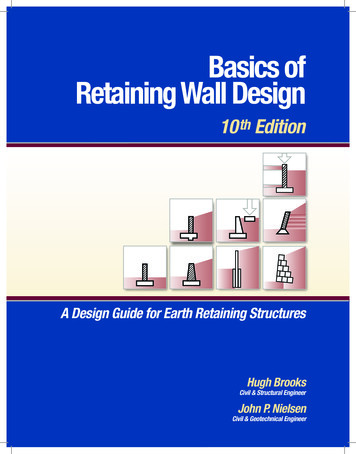
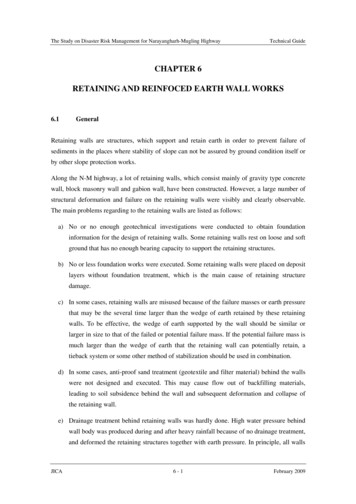

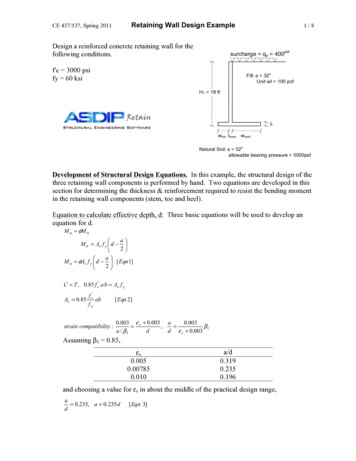
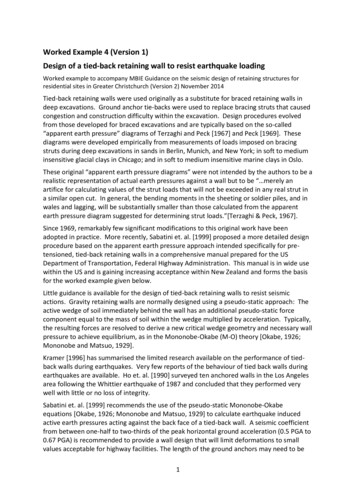

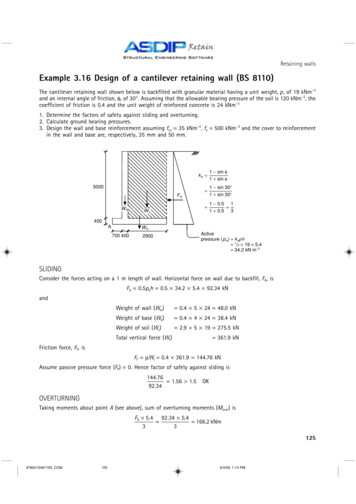
![20160924 修正版 System Keisoku ENG.ppt [互換モード]](/img/4/companyprofileinenglish.jpg)
